My garden has the blues and I couldn’t be happier about it.
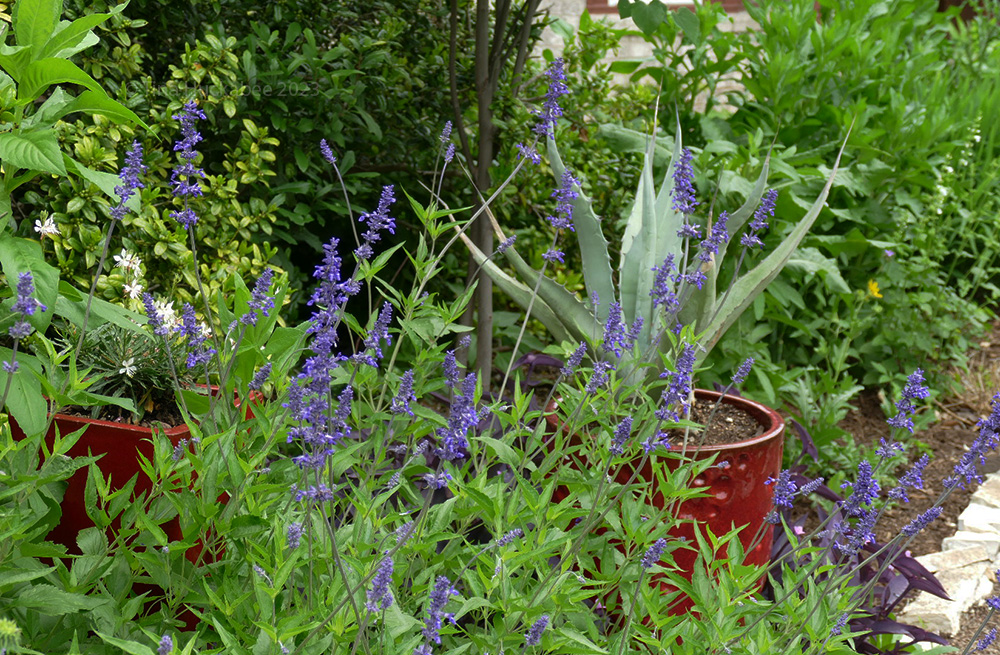
The full sun front garden is bursting with color in its second year of being, the blues not depressing either the garden or the gardener. I’m fond of blue flowers and grow several different species, most of which are native to Texas.
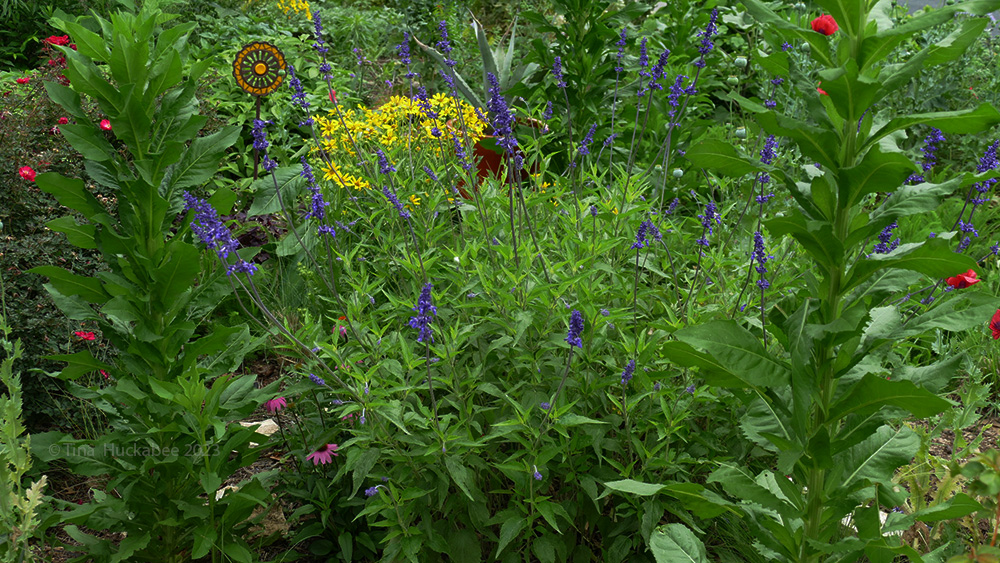
In this new garden I’ve planted five clumps of perennial Mealy Blue Sage ‘Henry Duelberg’, Salvia farinacea; all come from a plant I purchased years ago. This salvia is a late spring/summer/early fall bloomer and spreads by both seed and root. I should add that while it spreads, I don’t consider it aggressive; if a sprig pops up, it’s easy-peasy to yank out. It’s a dream to transplant: pull up a clump with roots, stick said clump in the ground, water a few times and it grows and blooms, beckoning the pollinators!
Mealy Blue Sage is favored by a wide variety of pollinators, like this honeybee. She is all-in for these small blooms.
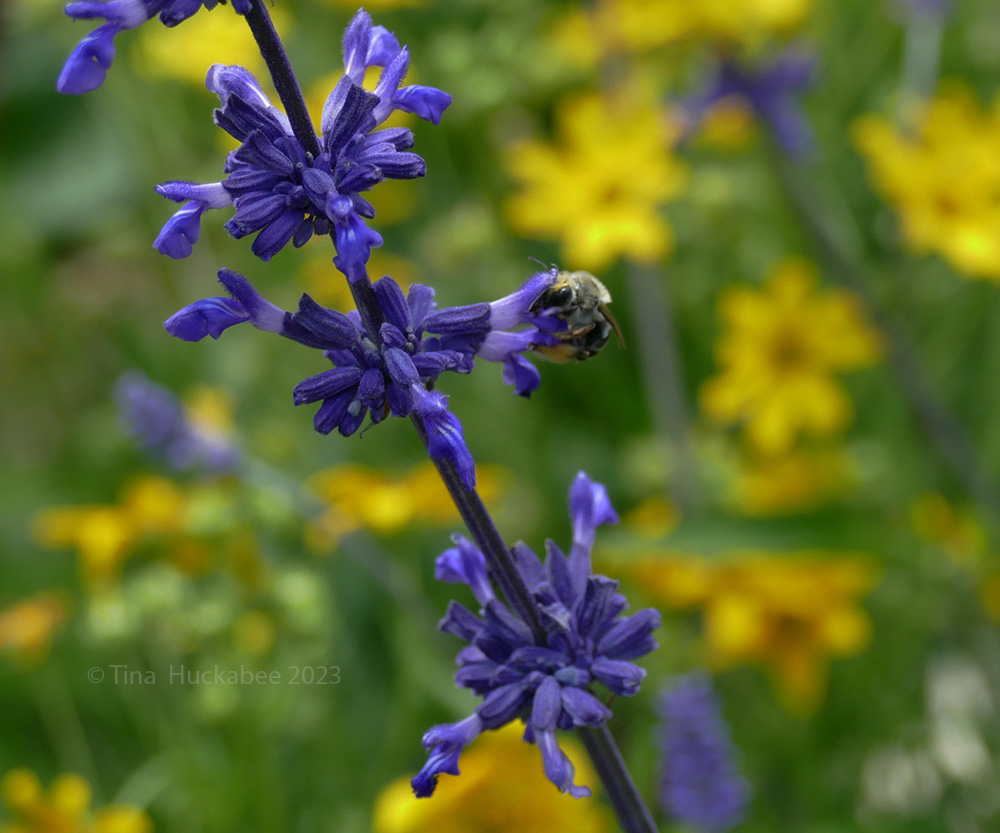
Bigger pollinators, like this Black Swallowtail, Papilio polyxenes, are fans of the mealy blues, too.
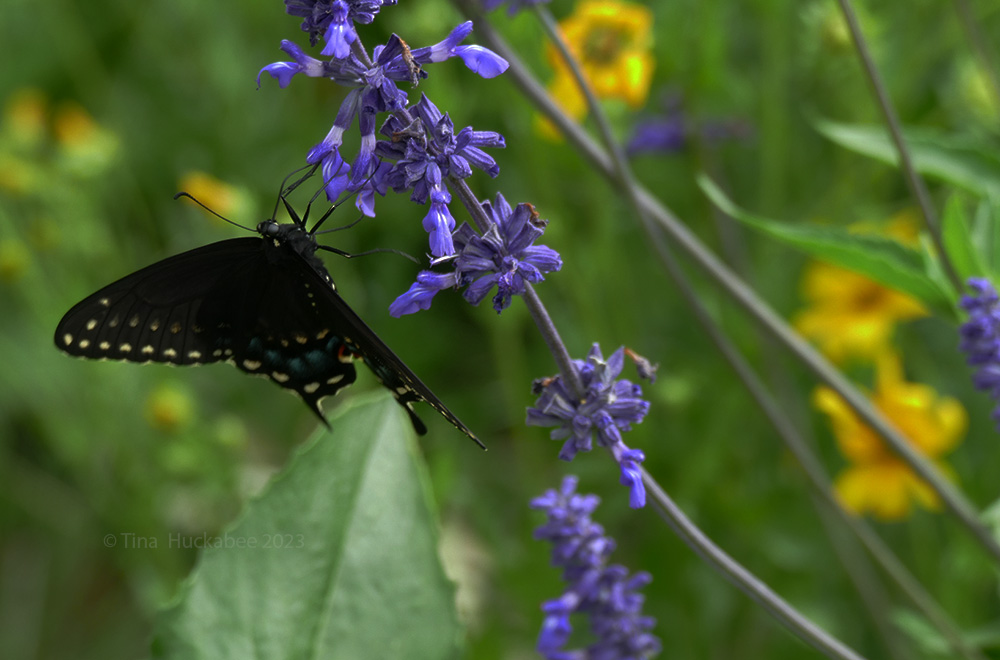
Another blue that makes me cheerful is Indigo Spires, Salvia x ‘Indigo Spires’. This perennial is a hybrid cross of the native Salvia farinacea and Salvia longispicata. I planted this specimen in my back garden a couple of years ago where it received some afternoon sun, but when the front garden morphed to full sun, I moved it there where it would get most-of-the-day sunshine, be a happier plant, and bring on the blues. Indigo is bigger than the ‘Henry Duelberg’, with longer bloom spikes and larger leaves.
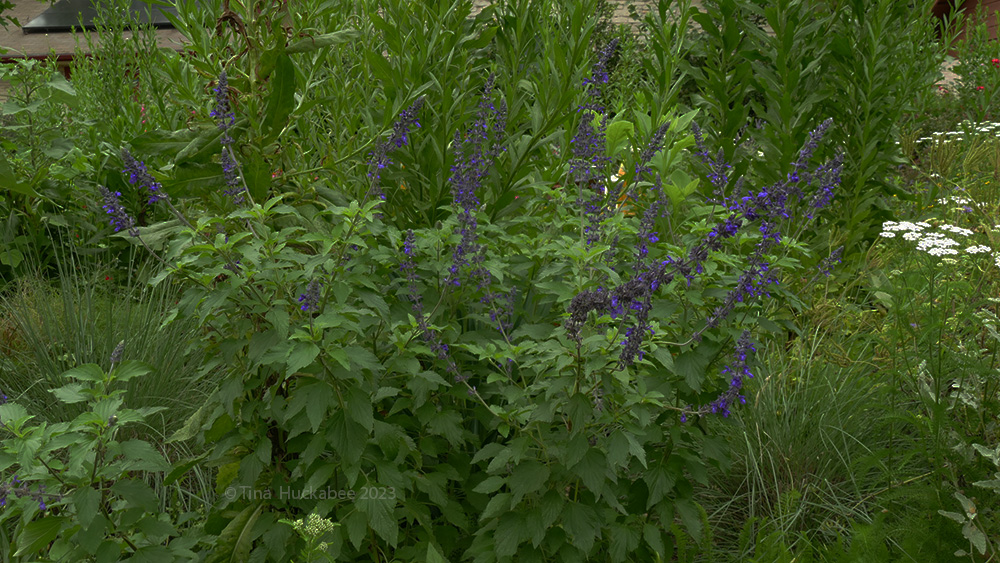
Many years ago when my back garden was full sun, I grew an Indigo Spires. In late summer and fall afternoons, there were often fifteen to twenty American Bumblebees working these blooms. Sadly, I haven’t seen that many bees on this plant, but the bees that are around definitely make a bee-line for these blues.
If there was an award for blues in the garden, I think it would go to the Blue Curls, Phacelia congesta. I didn’t mean to have so many this year and I should have culled some of the seedlings, but I am a softy. I have a hard time removing seedlings of desirable plants unless I have someone who will take them to another garden space. These are Texas annual wildflowers, so leaving them in place didn’t stress me too much as I knew that they’d be done with their show by mid-May when I could remove them, making room for the summer perennials.
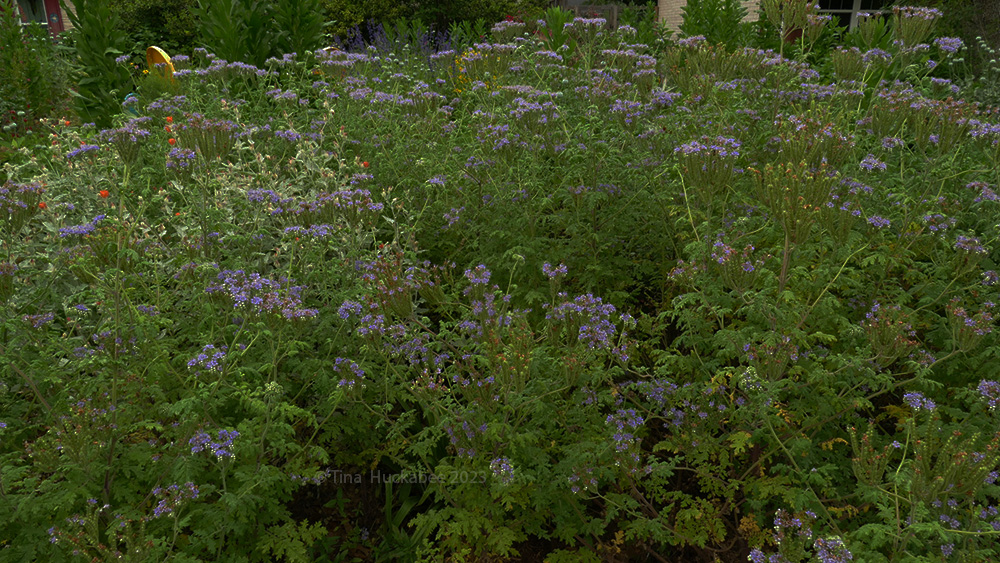
When the Curls reached the zenith of their flowering, there was a constant gentle buzzing in the garden and movement throughout the garden’s air. Honeybees, Carpenter bees, a myriad of tiny native bees, skippers and larger butterflies all flock to partake of these charming blue-violet flowers.
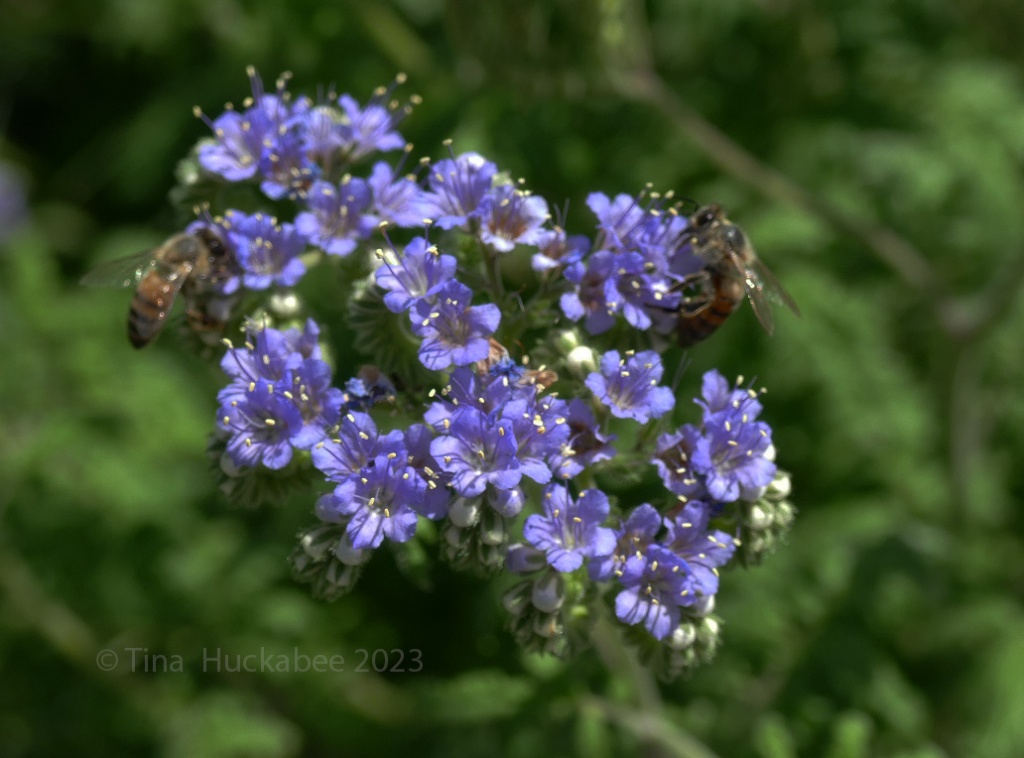
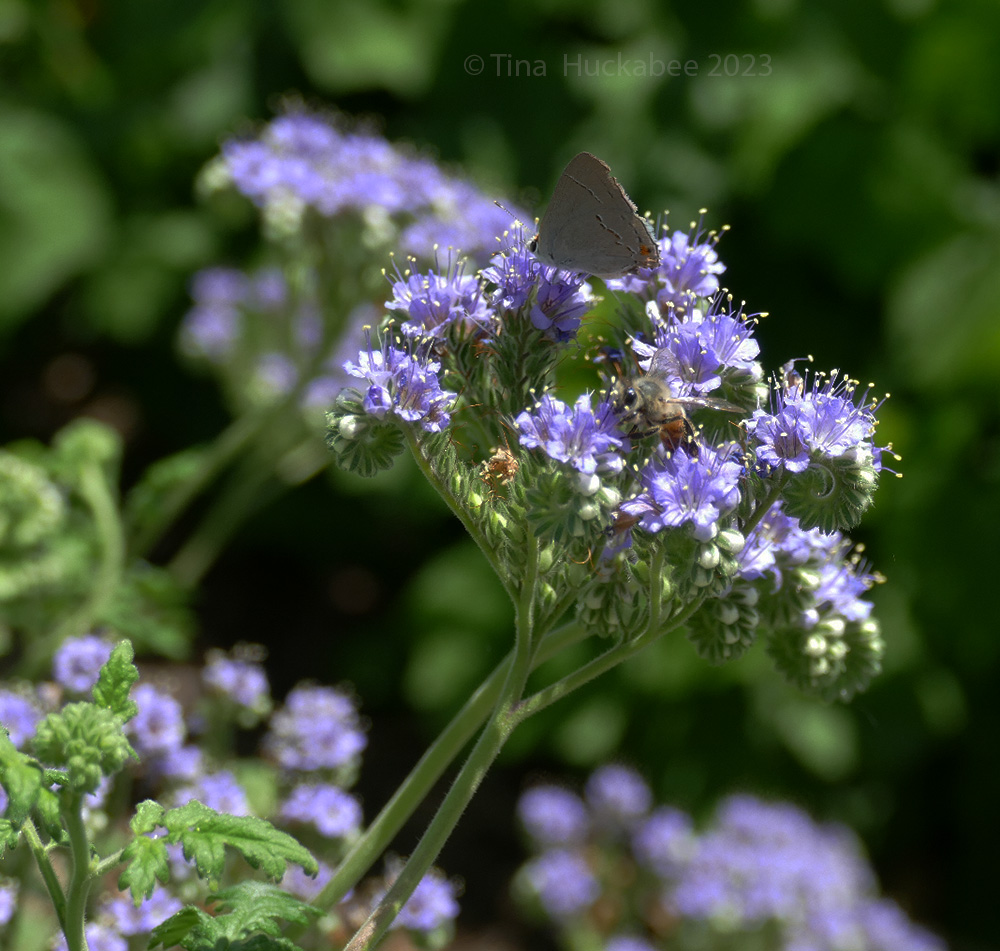
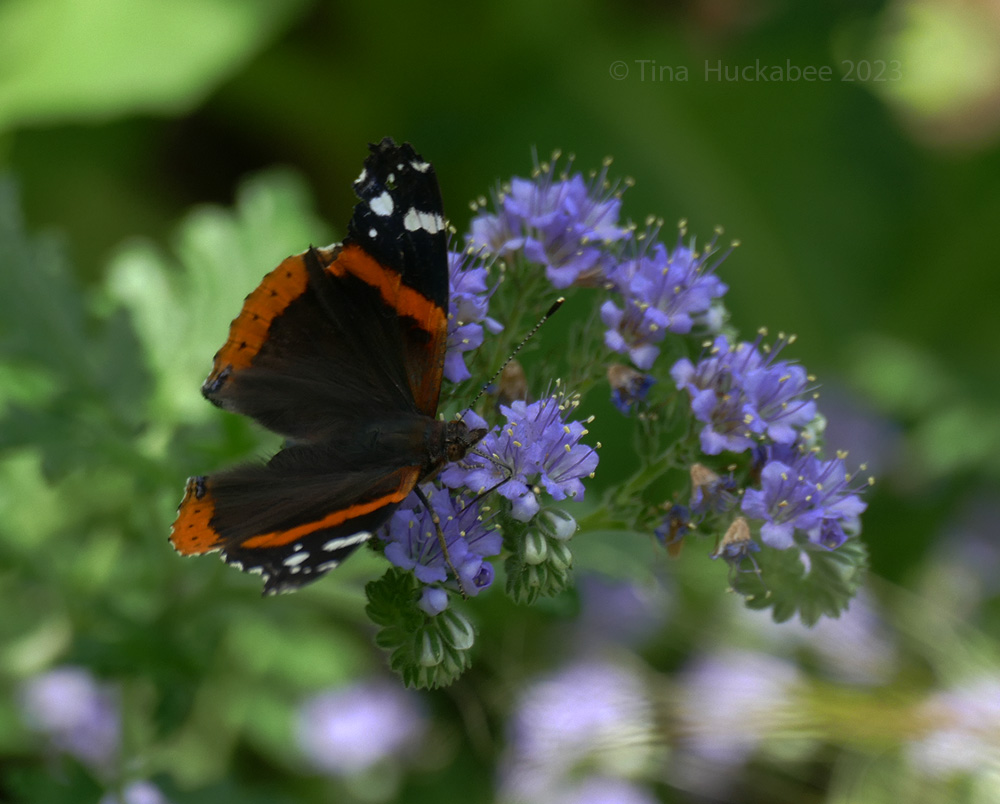
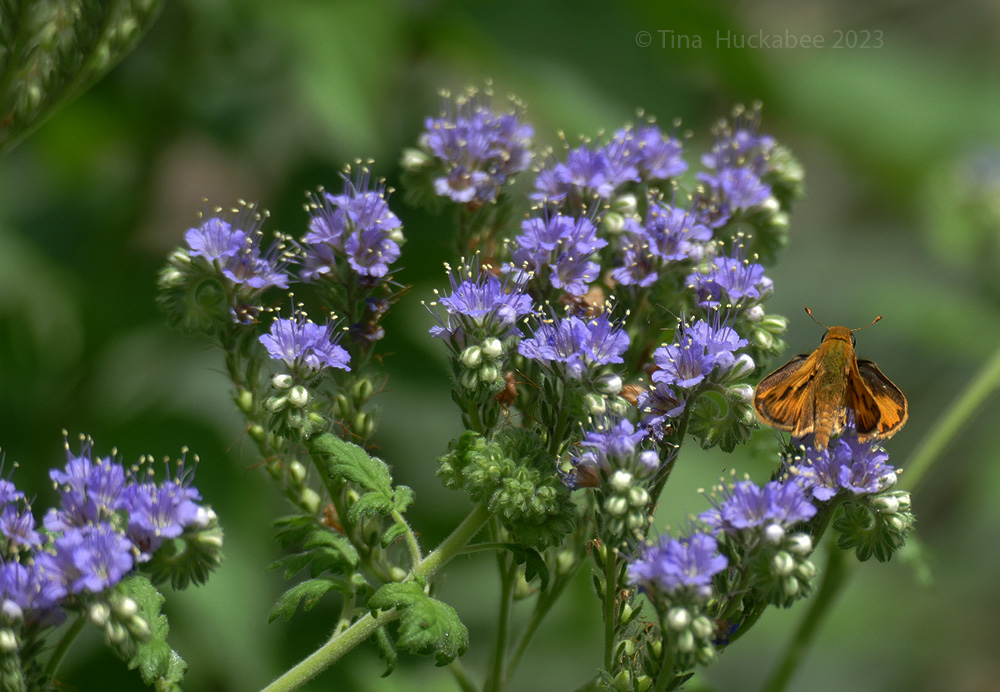
A variety of beetles and leaf-footed bugs got into the act of working these sweet blue blooms! Everybody, it seems, loves Blue Curls.
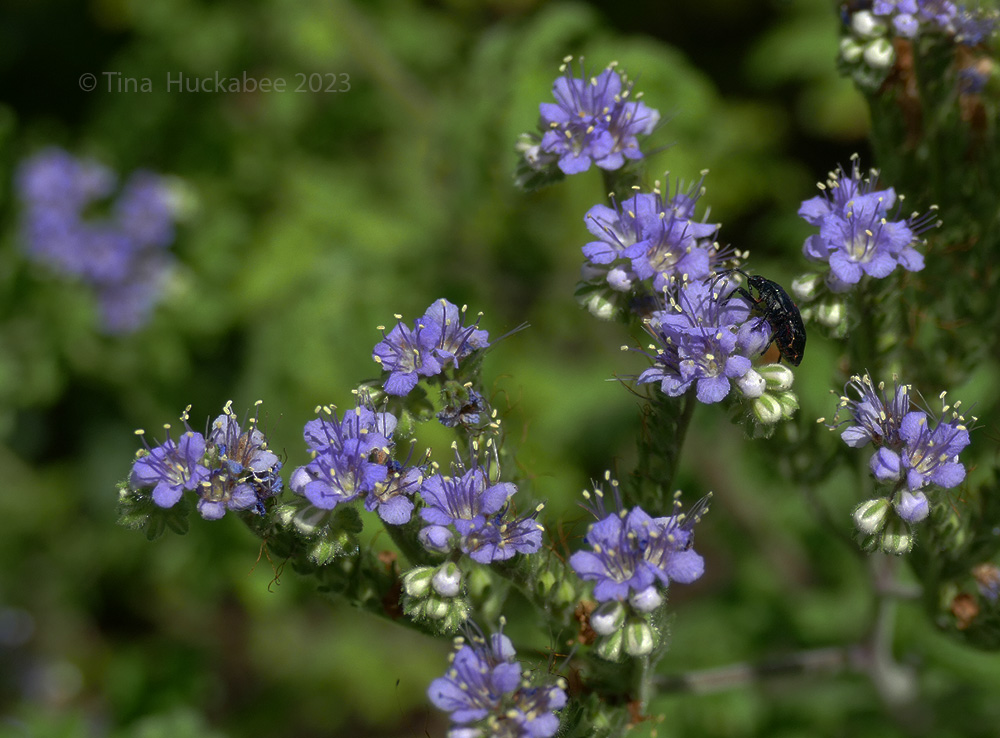
As the Curls’ blooms faded and the seeds developed, migrating songbirds were in the garden from dawn to dusk. I witnessed Common Yellowthroats, Lincoln’s Sparrows, Clay-colored Sparrows and Lesser and American Goldfinches noshing on the seeds and, no doubt, some of the tiny insects that were also on the plants. As these migratory birds fly northbound from my garden, they’ll pass along seeds to other places for next year’s wildlife.
Blue Curls are a cornucopia for wildlife. The insect and bird song, color, and life that these blue beauties brought to the garden during March and April eclipsed all other plants in the garden.
That’s why I didn’t remove them!
In the back garden, things are shadier, but the blues reign. Another violet-blue flowering plant is the perennial Heartleaf Skullcap, Scutellaria ovata and it thrives in part-shade.
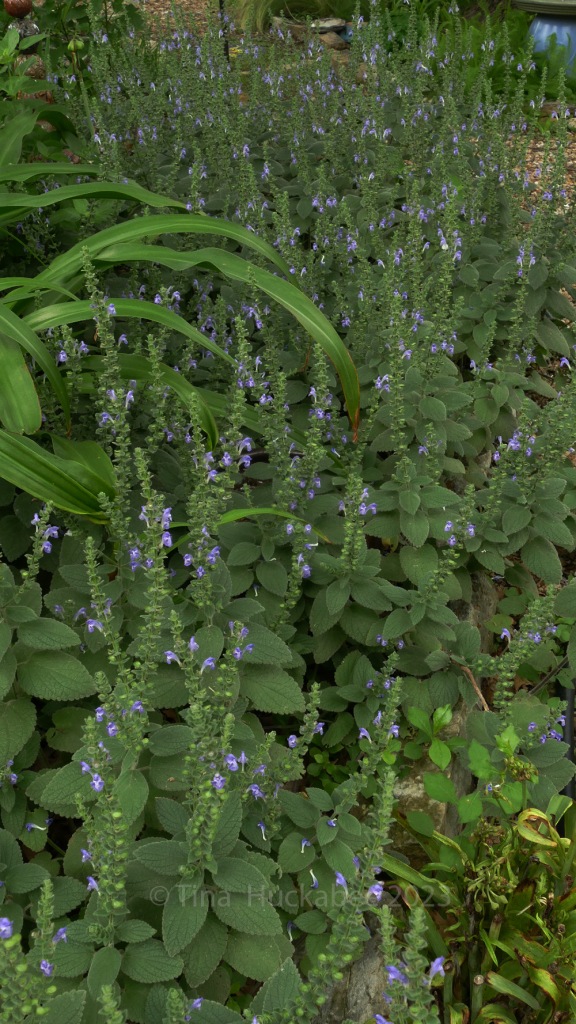
Velvety, grey-green foliage accompanies these diminutive blooms.

The grey-green stalks with fuzzy foliage appear in winter, fresh color against the freeze-rendered browns and tans. Heartleaf Skullcap spreads as a ground cover, adding blue bloom spikes atop the foliage from late spring through mid summer. Summer’s heat ends the blooms and fades the foliage; the plant eventually disappears. The gardener helps that process by shearing to the ground or pulling up the plant. Thick roots lie dormant in the soil, safe from the Texas heat, waiting patiently until cool winter, when it emerges with fresh stems and foliage, ready to grow and begin its cycle in the garden for a new season.
The pond’s water lilies are pink and yellow, but its bog plant, Pickerelweed, Pontederia cordata, rocks teeny violet-blue flowers borne on spiky stems. The plant sits in slow-moving water, blue spikes rise above luscious foliage.
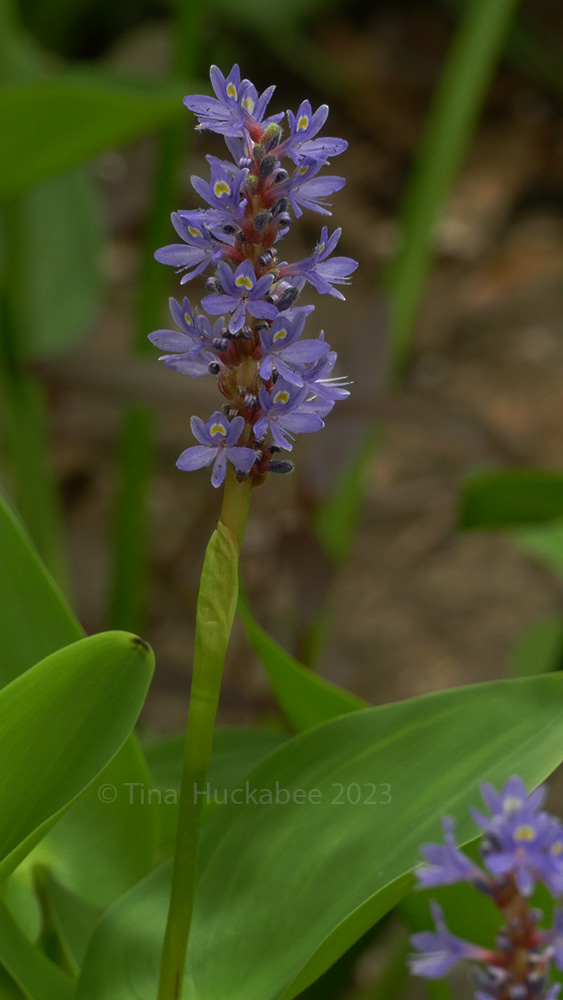
Many of my blues suggest a liaison with lavender or violet, but this final blue is a true blue: spring and autumn blooming Majestic Sage, Salvia guaranitica.
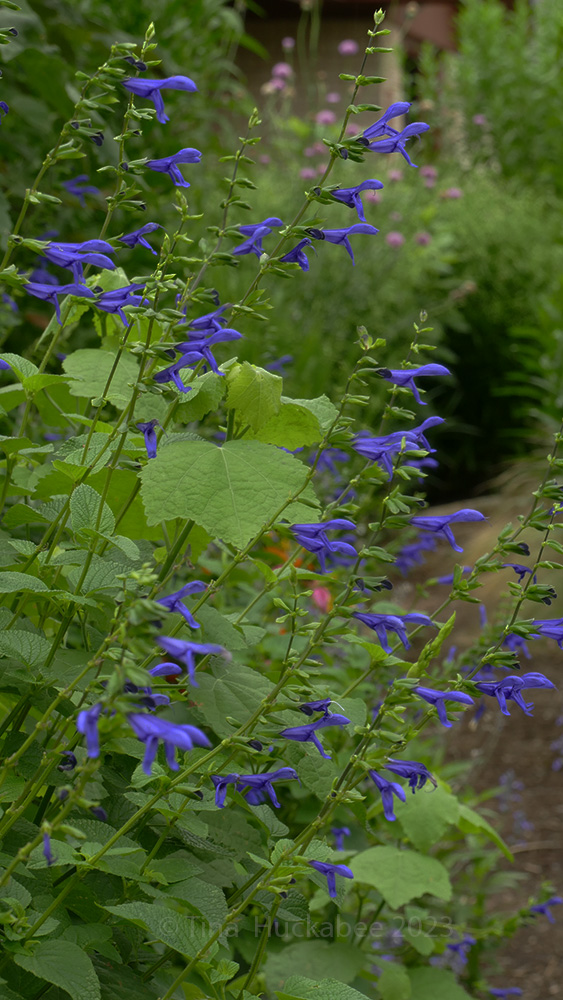
This is the only non-native blue that I grow; its home base is in Central and South America. A gorgeous, rich blue, the plant is colorful in spring and autumn, choosing to rest during the sweltering summer months. Most of the bees that visit nectar steal, though my honeybees and some of the tiny native bees crawl deep into the blooms for their sweet treat.
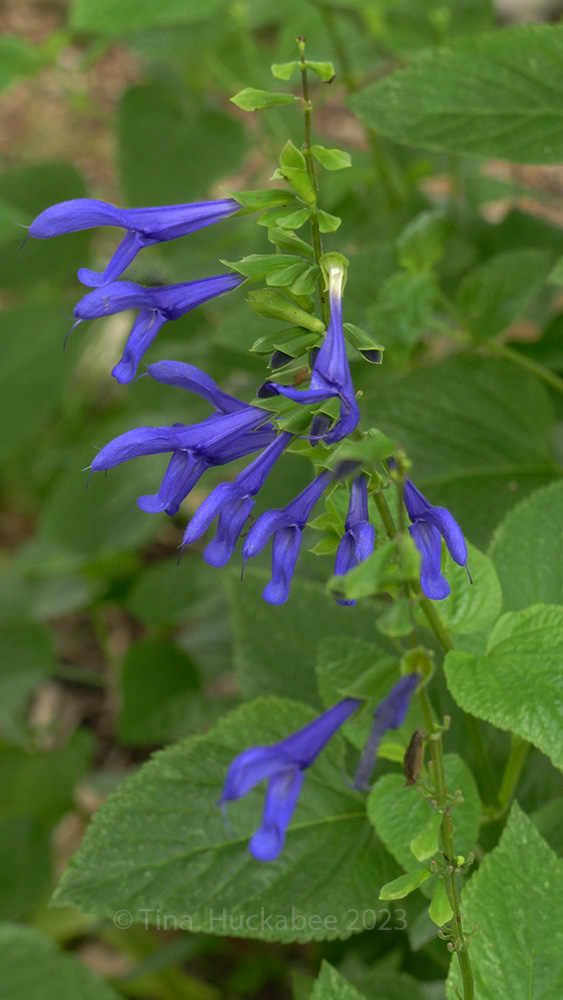
I grow a few other blues that will sing their songs in late summer and fall. The blues in a garden are the kind of blues we should welcome–for their beauty and for what they provide for the wild things we share space with. Add some blues to your garden, you’ll be happy you did!
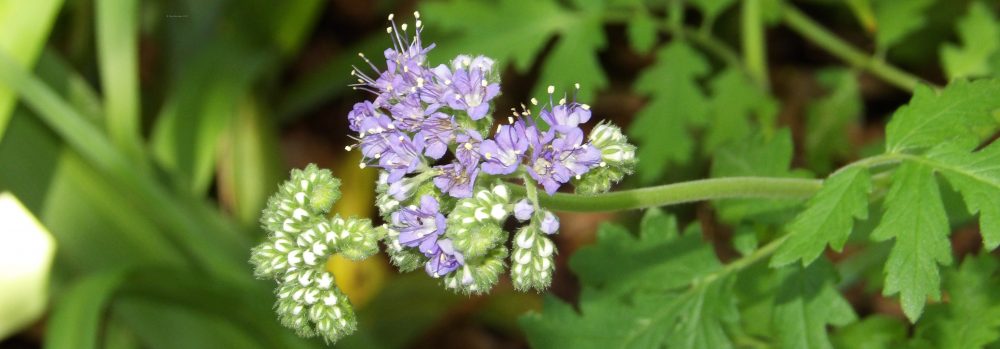
The fiery skipper’s color goes well with that of the blue curls. I wonder if there’s a wildflower and a butterfly that reverse the colors.
I’ve been trying to deduce what makes ‘Henry Duelberg’ different from the original species. The specimen you showed seems to have a darker, more intense color. Is that it, or do other characteristics distinguish it?
I’ve often wished more people knew about pickerelweed, which I find one of our most attractive wildflowers.
LikeLike
I love orange and blue together and the skipper was most accommodating!
‘Henry’ is so named because the plant was growing in a cemetery at or near Henry Duelberg’s grave–or so the story goes. It’s been marketed thus. It does seem that there is something of a range of blues that S. farinacea lends its name to and I’ll leave it to the horticulturalist to figure that out. I really like the ‘Henry Duelberg’–it’s such a lovely plant, tough and so great for pollinators and birds. There’s a white form of it that hybridizes–it’s named after Henry’s wife, Augusta. I used to have one that appeared when I grew these plants in my back garden. She disappeared in the shade, but I’m betting that at some point, I’ll find an ‘Augusta Duelberg’ in this front garden.
I love my pickerelweed, it’s a lovely plant and I couldn’t agree with you more about that.
LikeLike
Now these are the blues I wouldn’t mind having! 😉 Those blue curls sound like the perfect plant for attracting wildlife to the garden. I also love S. guarantica… its rich cobalt color can’t be beat!
LikeLike
The Curls were put on such a show this spring. I’ve had them for about 4 years, but this year they went nuts–and I’m glad they did.
I agree with you about the S. guaranitica. I wish it would bloom more when it’s hot, but it sulks a bit, so I prune it back and let it bloom up again in fall.
LikeLiked by 1 person
I have to ask — since you enjoy orange and blue together, have you added the blue and orange versions of scarlet pimpernel? I’ve been seeing those flowers run rampant recently, and when the combine, they’re absolutely gorgeous. And of course there’s the Tithonia, which I might plant if I were given to plant anything.
I’m not really fond of blue flowers — or so I say. But, I love bluebonnets, and blue curls, and downy lobelia, and blue pimpernel, so maybe it’s the ‘medium blues’ I’m not so fond of. I did find quite a bit of heartleaf skullcap recently, and didn’t know what it was. Now I do!
LikeLike
I’ve never grown the scarlet pimpernel, but have seen it (or think I have). I’ll bet it is pretty with its blue counterpart. I also like tithonia, but it’s another I haven’t grown. It’s interesting, because for a long time, I didn’t have much, if any, orange in my garden. I don’t really like orange that much; it’s just about the only color I don’t wear. But I’ve come to love some plants with orange flowers: Mexican Honeysuckle bush, Pride of Barbados, orange daylilies. I now have more orange than I once grew and they’re some of my favorite plant.
I’m with you on the blues: I don’t much care for light or medium blues, but I love dark, rich blues or blues with a violet/purple hue.
LikeLiked by 1 person
Not to brag – okay, so I am totally bragging – and this is totally irrelevant, but after being away for two weeks, I noticed that some of my blue ginger cuttings survived the worst frost since 1990 and are now growing! Blue is not an easy color. So much of what we consider to be blue is somewhat purplish. Lily of the Nile is blue, but is cliche. I know there is so much more than that.
LikeLike
Glad your ginger returned! That’s a win!
LikeLiked by 1 person
Yes! They are not actually a ginger, but I do enjoy their bloom.
LikeLiked by 1 person
Wow, what a stunning show of blues! Love the blue curls! Might have to see if the deer will eat them over here.
LikeLike
I just checked and according to the LBJWC, they have “high” deer resistance! https://www.wildflower.org/plants/result.php?id_plant=phco2 Woohoo!!
LikeLike
Love all the blues and can see why the insects are enjoying your garden.
LikeLike
Thanks, Donna–they certainly keep busy!
LikeLiked by 1 person